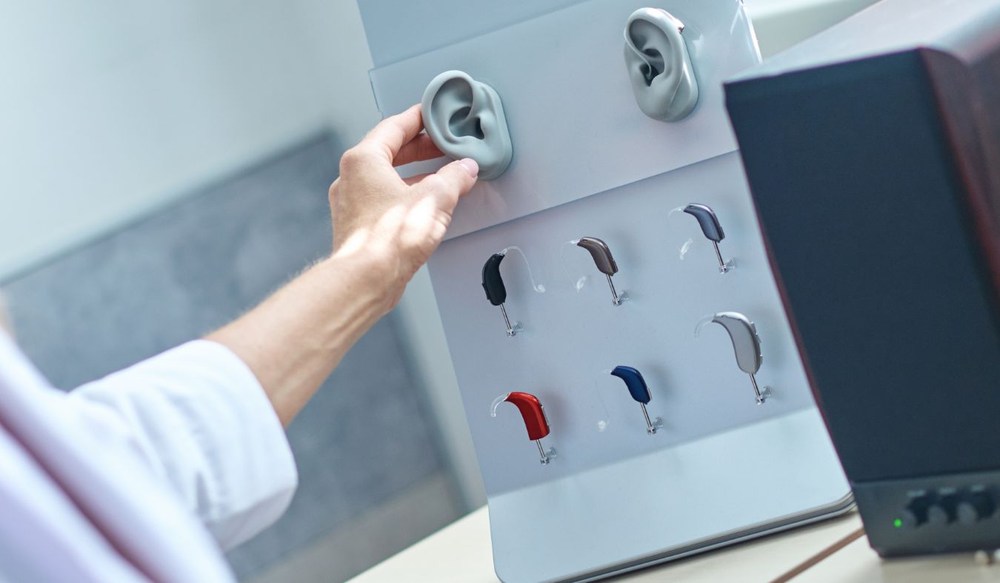Innovations in Hearing Aid Battery Technology
Battery technology has come a long way in recent years, and these

By: admin | September 24, 2025
Hearing care has changed significantly in recent years, going beyond the basic amplification devices people once relied on. Today’s hearing aids include advanced technology that can adjust to different listening environments, adapt to individual preferences and process sound in a way that better matches daily life. These developments provide practical solutions for people with hearing loss, helping them engage more naturally in conversations and everyday activities.
Much of this progress is driven by the real-world data collected from hearing aid wearers during daily use. Each time a device is worn, it records information about sound environments, usage patterns and listening habits. When this information is analyzed across many wearers, it offers insights that guide improvements in technology and help audiologists understand how hearing loss affects people in real situations. This approach makes hearing solutions more practical and tailored, focusing on actual experiences rather than theoretical assumptions.
Big data plays an increasingly important role in modern healthcare by providing a more detailed understanding of how individuals interact with treatments and devices. Collecting information from large groups of people, audiologists and researchers can identify patterns and trends that would be difficult to see from individual cases alone. This type of analysis goes beyond traditional clinical testing, offering insight into how patients experience daily life, manage conditions and respond to therapies. With these insights, healthcare solutions can be refined to better meet the real needs of individuals, improving both outcomes and overall quality of care.
In addition to shaping treatment approaches, big data helps improve usability and effectiveness across technologies. Information about individual preferences, adjustments and long-term patterns allows designers and professionals to create solutions that are more intuitive and responsive. For example, devices and programs can be tailored to accommodate the environments and routines people encounter most often, reducing frustration and increasing engagement. Relying on this data-driven approach, healthcare becomes more personalized, practical and aligned with the actual experiences of the individuals it serves.
Hearing aids gather data through built-in sensors and software that monitor how the device is used throughout the day. They can track the volume settings, program changes and how long the hearing aids are worn in different environments. Some devices also record the types of sound settings, like quiet rooms, conversations or noisy outdoor spaces. This information is stored directly on the device and can be uploaded to specialized software for review. Collecting these details automatically, hearing aids provide an accurate record of daily usage without requiring extra effort from the wearer.
The data is gathered continuously as the hearing aids are worn, capturing information in real time. This includes how the device responds to different background noises and which features are adjusted most frequently. Some hearing aids can even detect when the wearer moves between environments, like from indoors to outdoors and log these transitions. The information is collected securely within the device and can later be shared with an audiologist for analysis. This automatic collection process ensures a complete and detailed picture of how the hearing aids are being used over time.
Modern hearing aids function as sophisticated data collection systems that monitor how individuals interact with their world throughout each day. They track basic usage information like when the devices are turned on and off, which can reveal important patterns about a person’s daily routine and hearing needs. The devices also record the volume levels that wearers prefer in different situations, helping to understand individual comfort zones. Additionally, they monitor how often individuals manually adjust settings, which shows whether the automatic features are working well or need improvement. This usage data provides a foundation for understanding how hearing aids fit into someone’s lifestyle.
The devices also gather detailed information about the acoustic environments that you encounter regularly. They can identify specific types of sounds, like music, traffic noise or multiple people talking at once and note how the hearing aid responds to each situation. Some models track the frequency ranges that are most challenging for individuals, creating a personalized hearing profile over time. The devices record how successful they are at reducing background noise while preserving speech clarity in various settings. This environmental data helps manufacturers understand the real-world challenges that hearing aid wearers face and develop better solutions for common listening situations.
You may notice that hearing aids work well in some places but not as well in others. Busy cafes or family gatherings, for example, can make it harder to hear conversations. Big data helps by collecting information from thousands of individuals about where and when these listening challenges occur. When similar issues are reported by many people, manufacturers can use this information to improve future devices. This process helps address common problems more quickly. Over time, this leads to better features and settings that help you hear clearly in the situations that matter most.
Big data plays a major role in making hearing aids more responsive to your needs. Collecting information about where and how you use your device, manufacturers can fine-tune settings to fit your daily routine. Your hearing aid can adjust itself whether you are in a lively restaurant or relaxing at home.
Many people notice that their hearing aids do not always perform the same in every situation. For example, background noise in crowded places can make it difficult to follow conversations. Big data addresses this by allowing your device to learn from your listening environments over time. Your hearing aid then automatically adapts its settings, helping you hear more clearly wherever you are.
Hearing aids collect a variety of data that can be carefully analyzed to improve how sounds are experienced. Examining patterns in the sounds detected helps engineers and audiologists identify which frequencies or situations might need adjustments. This process allows the devices to fine-tune amplification, reduce unwanted noise and make speech clearer in different environments. Analysis of the collected data also helps in understanding how sounds interact with the wearer’s surroundings, leading to more precise and natural listening experiences. Over time, this careful review ensures that hearing aids provide consistent, high-quality sound tailored to real-life situations.
Advanced data tools help manufacturers identify patterns in how people hear in noisy environments like restaurants or busy streets. Analyzing large amounts of information from many individuals, they can pinpoint which background noises cause the most trouble and which settings help people hear better. This knowledge allows for improvements in how hearing aids handle sudden loud sounds or multiple voices at once. As a result, your device can adjust more quickly and accurately when you move from a quiet place to a noisy one, reducing frustration in difficult listening situations.
Real world feedback is vital for making hearing aids more helpful in your daily life. When wearers share their experiences, manufacturers can use this information to improve device performance. Feedback often highlights specific situations where hearing aids could do better, like understanding speech in crowded rooms or adjusting quickly to sudden changes in noise. Reviewing these comments, manufacturers can update software and features to address common concerns and add new options that people want. This ongoing process ensures that hearing aids continue to improve as technology advances and more feedback is collected.
Modern hearing aids can track patterns of daily use, which provides valuable insight into how long batteries typically last under real-world conditions. Analyzing when devices are worn most, how often volume or program settings are changed and the types of environments encountered helps identify opportunities to make batteries more efficient. This information allows engineers to design power management systems that prioritize energy for the features used most frequently. Over time, the data can also guide improvements to charging habits or device alerts, ensuring batteries last as long as possible throughout the day. Studying usage trends helps hearing aids become more reliable, supporting longer performance without frequent interruptions.
Your preferences play a big role in making hearing aids more comfortable for all-day wear. When you adjust your device for volume, sound balance or special listening programs, this information is collected and used to improve comfort. Manufacturers use these insights to design hearing aids that fit better with your habits and needs. This can also lead to new materials or shapes that feel better on your ear, making it easier to wear your device for longer periods. For example, some devices now feature soft silicone tips or lightweight designs based on wearer feedback about comfort.
Protecting your personal information is a top priority when big data is used in hearing aid technology. Manufacturers and audiologists follow strict privacy rules to keep your data secure. Your information is stored safely and used only to improve device features or provide better care. Most companies use systems like encryption and regular security checks to keep your details private. Knowing these protections are in place can help you feel more confident about how your data is handled while still benefiting from the latest advances in hearing aid technology.
When considering big data and hearing aids, asking the right questions helps you make an informed choice. Understanding how your information is used can give you peace of mind. Some questions to consider:
These questions help you learn how each device uses big data to make sound clearer and more comfortable for you. Knowing what information is gathered and how it is protected gives you a clearer idea of which hearing aid may fit your needs best.
Big data is changing how hearing aids are designed and improved, making it possible for devices to better match your needs and daily life. Collecting and analyzing real user information, manufacturers can create hearing aids that offer clearer sound, more comfort and helpful features like remote adjustments. This progress means technology continues to advance with each update.
If you would like more information about how big data can help you find the right hearing aid or have questions about the latest features, at ChEARS Hearing Center in San Diego, CA we are here to help. Call us at (619) 717-2601. We are here to explain your options and help guide you toward a solution that fits your lifestyle.
Tags: hearing aid basics, hearing aid repair, hearing aid styles

Battery technology has come a long way in recent years, and these
By: admin | November 18, 2025

Hearing care has changed significantly in recent years, going beyond the
By: admin | September 24, 2025

Hearing aids have come a long way from being simple sound amplifiers –
By: admin | May 23, 2025
